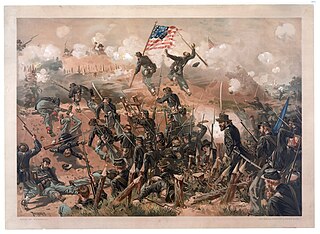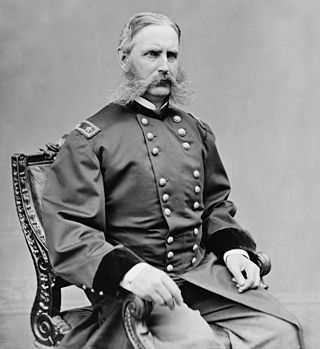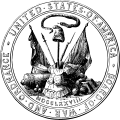
The Siege of Vicksburg was the final major military action in the Vicksburg campaign of the American Civil War. In a series of maneuvers, Union Major General Ulysses S. Grant and his Army of the Tennessee crossed the Mississippi River and drove the Confederate Army of Mississippi, led by Lieutenant General John C. Pemberton, into the defensive lines surrounding the fortress city of Vicksburg, Mississippi, leading to the successful siege and Confederate surrender.

The Vicksburg campaign was a series of maneuvers and battles in the Western Theater of the American Civil War directed against Vicksburg, Mississippi, a fortress city that dominated the last Confederate-controlled section of the Mississippi River. The Union Army of the Tennessee under Major General Ulysses S. Grant gained control of the river by capturing this stronghold and defeating Lieutenant General John C. Pemberton's forces stationed there.

The Army of the Tennessee was a Union army in the Western Theater of the American Civil War, named for the Tennessee River. A 2005 study of the army states that it "was present at most of the great battles that became turning points of the war—Fort Donelson, Vicksburg, and Atlanta" and "won the decisive battles in the decisive theater of the war."

The Army of the Cumberland was one of the principal Union armies in the Western Theater during the American Civil War. It was originally known as the Army of the Ohio.
Army of the Mississippi was the name given to two Union armies that operated around the Mississippi River, both with short existences, during the American Civil War.
The Army of West Mississippi was a Union army that served in the Western Theater of the American Civil War. It was virtually the same force as the Army of the Gulf, but was renamed when it became a part of the Military Division of West Mississippi, in the Department of the Gulf commanded by Maj. Gen. Edward Canby.
XIII Corps was a corps of the Union Army during the American Civil War. It was first led by Ulysses S. Grant and later by John A. McClernand and Edward O.C. Ord. It served in the Western Theater of civil war, Trans-Mississippi Theater and along the Gulf of Mexico.

The XVI Army Corps was a corps of the Union Army during the American Civil War. The corps rarely fought as a single unit, as its divisions were often scattered across the country.

XVII Corps was a corps of the Union Army during the American Civil War. It was organized December 18, 1862 as part of Ulysses S. Grant's Army of the Tennessee. It was most notably commanded by Maj. Gen. James B. McPherson and Maj. Gen. Francis P. Blair II, and served in the Western Theater.

XIX Corps was a corps of the Union Army during the American Civil War. It spent most of its service in Louisiana and the Gulf, though several units fought in Virginia's Shenandoah Valley.

The Maryland campaign occurred September 4–20, 1862, during the American Civil War. The campaign was Confederate General Robert E. Lee's first invasion of the North. It was repulsed by the Army of the Potomac under Maj. Gen. George B. McClellan, who moved to intercept Lee and his Army of Northern Virginia and eventually attacked it near Sharpsburg, Maryland. The resulting Battle of Antietam was the bloodiest day of battle in American history.

The Chickamauga campaign of the American Civil War was a series of battles fought in northwestern Georgia from August 21 to September 20, 1863, between the Union Army of the Cumberland and Confederate Army of Tennessee. The campaign started successfully for Union commander William S. Rosecrans, with the Union army occupying the vital city of Chattanooga and forcing the Confederates to retreat into northern Georgia. But a Confederate attack at the Battle of Chickamauga forced Rosecrans to retreat back into Chattanooga and allowed the Confederates to lay siege to the Union forces.

Andrew Jackson Smith was a United States Army general during the American Civil War, rising to the command of a corps. He was most noted for his victory over Confederate General Stephen D. Lee at the Battle of Tupelo, Mississippi, on July 14, 1864.

The Battle of Chickasaw Bayou, also called the Battle of Walnut Hills, fought December 26–29, 1862, was the opening engagement of the Vicksburg Campaign during the American Civil War. Confederate forces under Lt. Gen. John C. Pemberton repulsed an advance by Union Maj. Gen. William T. Sherman that was intended to lead to the capture of Vicksburg, Mississippi.

The western theater of the American Civil War encompassed major military operations in the states of Alabama, Georgia, Florida, Mississippi, North Carolina, Kentucky, South Carolina and Tennessee, as well as Louisiana east of the Mississippi River. Operations on the coasts of these states, except for Mobile Bay, are considered part of the Lower Seaboard Theater. Most other operations east of the Appalachian Mountains are part of the eastern theater. Operations west of the Mississippi River took place in the trans-Mississippi theater.
The trans-Mississippi theater of the American Civil War was the scene of the major military operations west of the Mississippi River. The area is often thought of as excluding the states and territories bordering the Pacific Ocean, which formed the Pacific coast theater of the American Civil War (1861–1865).

Christopher Columbus Augur was an American military officer, most noted for his role in the American Civil War. Although less well known than many other army contemporaries, he was considered an able battlefield commander.

George Leonard Andrews was an American professor, civil engineer, and soldier. He was a brigadier general in the Union Army during the American Civil War and was awarded the honorary grade of brevet major general.
The Battle of Fort DeRussy, Louisiana, was the first engagement in the Red River Campaign of March–May 1864 in the American Civil War.
The 41st Regiment Massachusetts Volunteer Infantry was a three-year infantry regiment that served in the Union Army during the American Civil War. It was recruited as part of Governors Banks' and Andrew's recruitment drives to supply the union with a military force to hold and expand Union control of the lower Mississippi. In the late winter/early spring of 1863, it was converted to mounted infantry and later to cavalry. On its conversion in June 1863 at Port Hudson, it was disestablished and re-established as the 3rd Massachusetts Volunteer Cavalry.















